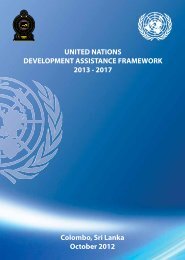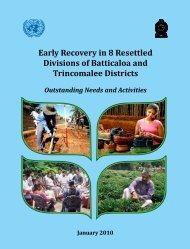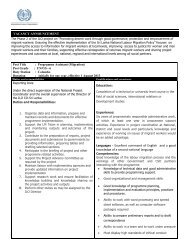Sri Lanka Human Development Report 2012.pdf
Sri Lanka Human Development Report 2012.pdf
Sri Lanka Human Development Report 2012.pdf
You also want an ePaper? Increase the reach of your titles
YUMPU automatically turns print PDFs into web optimized ePapers that Google loves.
Women’s engagement<br />
Currently, there are 13 women members of Parliament out<br />
of a total of 225; the portion is less than 6 percent, a figure<br />
that has remained unchanged from 2004 to 2010 (Table<br />
6.6). This is not a recent trend, since women’s representation<br />
in political institutions has been minimal in the 60 years<br />
since independence, despite a constitutional guarantee of<br />
equality, policy statements about commitments to equal<br />
representation, the ratification of the Convention on<br />
the Elimination of All Forms of Discrimination against<br />
Women (CEDAW), and sustained activism and advocacy<br />
by civil society organizations. 320<br />
Reasons for the low representation of women in politics 321<br />
start at the personal level, where fewer women than men<br />
self-select themselves for a political career because of sociocultural,<br />
economic and psychological barriers. In political<br />
parties, women are mostly ignored as candidates, and in<br />
elections, many voters prefer to vote for men.<br />
Available evidence suggests that political parties are the<br />
single biggest barrier to women’s greater participation<br />
in politics. The Women and Media Collective noted in<br />
2011 that, “the main obstacle to women’s equal political<br />
representation remains within Political Parties, since<br />
they do not nominate an equitable number of women to<br />
contest elections.” 322 Of the 6,060 persons nominated for<br />
Parliament in 2004, only 375, or 6.2 percent, were women,<br />
close to the share in Parliament.<br />
Recently, there has been an increase in the number and<br />
percentage of women nominated, 323 but this mainly<br />
results from greater competition for political support<br />
based on proportional representation. Because this may<br />
be a strategy to attract voters, and because nominations<br />
do not equal representation, women are likely to remain<br />
largely excluded from politics.<br />
The major political parties have only shown limited<br />
commitment to enhancing their political representation,<br />
despite heavy national advocacy and campaigning by<br />
various groups. For the 2010 parliamentary election, the<br />
United People’s Freedom Alliance (UPFA) and the United<br />
National Front (UNF) each nominated 15 women out<br />
of a total of 262 nominations (5.7 percent). The smaller<br />
political party, the Democratic National Alliance (DNA),<br />
nominated women as only 3.4 percent of candidates.<br />
The share of women nominated in 2008-2009 was even<br />
smaller: 4.3 percent by the UPFA, 3.8 percent by the UNF<br />
and 3.3 percent by the JVP (Table 6.7).<br />
Undeterred, the Women and Media Collective has actively<br />
lobbied political parties to increase nominations of women.<br />
It has sought to engage women in political campaigns and<br />
encourage voters to choose women candidates regardless<br />
of political party. Recent advocacy campaigns have called<br />
for the introduction of a quota for women in nomination<br />
lists, as well as the imposition of a 40 percent quota in<br />
Parliament. These demands remain unmet, however, while<br />
the motivation of political parties and the Government to<br />
move forward is not coming forth.<br />
At the sub-national level, women’s representation<br />
improved only marginally from 1966 to 2006: from 1.1<br />
percent to 3 percent in the municipal councils, and from<br />
1.9 percent to 3.4 percent in the urban councils. Among<br />
the pradeshiya sabhas, women occupied a mere 1.6 percent<br />
of positions. 324 From 2002 onwards, the representation of<br />
women at the provincial and local levels has decreased,<br />
even as it remained largely unchanged in Parliament.<br />
The ethnic make-up is wholly in favor of one group.<br />
The Women and Media Collective notes that, “the majority<br />
of women currently represented in elected political<br />
institutions are women from the Sinhala Community;<br />
women from the minority Tamil and Muslim communities<br />
are further marginalized from these bodies. There is only<br />
one Tamil woman and no Muslim woman in the current<br />
Parliament.” 325<br />
Chapter 6 Bridging Governance Gaps: State Capacity and People’s Participation 115






